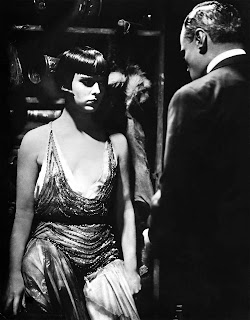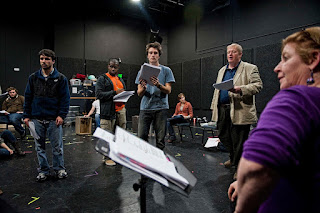Pandora
PANDORA’S BOX
PANDORA’S BOX
Pandora’s Box is a place of delights. Every time you open it,
you find something rich, strange and surprising…Pandora’s Box the series is a
place where the studio based television drama is re-invented. Where the small
screen does not attempt to be a window on the world. Rather, it is a doorway
into the mind.
Inspired by such “portmanteau” shows of the past, such as
Alan Bennett’s Talking Heads and shows of the recent past like “Inside No 9”,
in every 30 minute episode, Pandora will present from her “studio” a completely
self- contained drama…sometimes funny, sometimes scary, sometimes poignant, but
always strangely hopeful.
Deriving from the first influence comes an emphasis on
character and situation…and a strictly limited palette of performance suitable
to current restraint on production. From the second comes a ruthless attention
to form and playful exploration of genre conventions.
What makes the series unprecedented is its entirely unique
approach to “realism.” It will simply
dispense with it. Each film will be made on a single soundstage in a strictly
limited amount of time. The audience
will be asked to notice and celebrate the “madeness” of the pieces and their
setting. The soundstage will be made
into a world using the extraordinary skills of stage designers and lighting
designers as well as actors and writers. It will make no attempt to pretend to
be a “real” location.
It has been a limitation of studio based drama historically that
a set always looks like a set, no matter how skilled the design. This series evades that problem by meeting it
head on. What is “real” is not the set, what is real is the human situation of
the character or characters. The design represents that state of mind and present
tense situation. We make no attempt at naturalism. This drama is not discovered BY the audience,
it is presented TO them for their delectation.
In this way, within the constraints of both budget and
safety regulation under current conditions, TV drama in Scotland can both draw
on a talent pool of extraordinary depth, much of it new to television, and
re-invent studio based TV production at the same time. We can offer something that feels new, and
has no need to apologise for not looking like anything you’ve seen before.
This selling point has some provenance. “Pandora’s Box” was
a key film in the tradition of German Expressionist cinema in the 1920s…with
it’s huge influence on the “fantastic” elements in cinema ever since, and I
think, a hundred years later, we can once again challenge the assumptions of
“realism/naturalism” in filmed drama and look for different, heightened
reality…
We can make TV that represents a “state of mind” rather than
even ATTEMPTING to look like “objective reality.” Subjectivity is not a
mistake…it is the guiding spirit of the show!
Each half hour should set up a state of mind to be
challenged and changed. Each episode
should be very different in style and content…from period to comedy to
thrillers and scary stuff…At the same time, such a series has the advantage of
being able to be made in fairly short order as well as at limited costs. It can have the added bonus of support to the
best of Scotland’s world leading theatre industry at a crucial time, and to
point the way forward to the continuing economic and cultural value of that
sector.
My initial suggestion is that a first season, again in the
interests of time, might look to existing Scottish Theatre texts as the basis
for adaptation to this new medium…that experiments take place on texts that
have already proven themselves in front of an audience. These texts should be curated and adapted by
the writers involved in collaboration with the Pandora’s Box Creative team.
What follow are simply a series of my personal ideas. These are based for reasons of time as well
as production costs, on scripts that already exist, that can be easily cut and
adjusted to the half hour format and the kind of production I have in mind,
especially in the “early days” under restricted production conditions.
If this idea ever made the jump to series, then it should
feature the work of different writers, but strongly curated by a shared
sensibility of entertainment and bravura.
Some feature one actor, some two or even three! In each, the
full range of digital sound and visual effects can be used to enhance and
intensify the mood…and get us away as far away from the “seventies” feel of
studio dramas as we can get!
For example, in “The Signalman,” a railway worker in his
sixties relives the events of the terrible night of the Tay Bridge disaster
forty years before. He was alone then in
a dark, storm tossed world. He is alone
again now, transported into a magically rendered memory, psychologically
compelled into both the terrifying crowds of the accident enquiry, where he was
afraid of being blamed, and his journey crawling out in pitch darkness onto the
shattered bridge itself…till we learn at the end that his journey was initiated
because he has received a telegram that morning informing him of his grandson’s
death from influenza in 1919. In “Serov’s People,” three portraits in the
corner of a closed Art gallery come to life in their very own take on “Night in
The Museum,” aware of the absurdity of their predicaments and discovering why
they were memorialised in these pictures in the first place. In “Shall Roger
Casement Hang?” Based on the remarkable true story of Roger Casement and his
treason trial in 1916…interrogation by a clever and brutal naval officer
summons the ghosts of Casement’s sexual and political past…Or in “Face”, one
actress plays twin sisters, switching between them in real time as they meet to
talk about their mother’s legacy…which only one has inherited…
(This last has been tried out in a “Lockdown self-filmed on a
phone!” extract for the Scotsman Newspaper)





Comments
Post a Comment